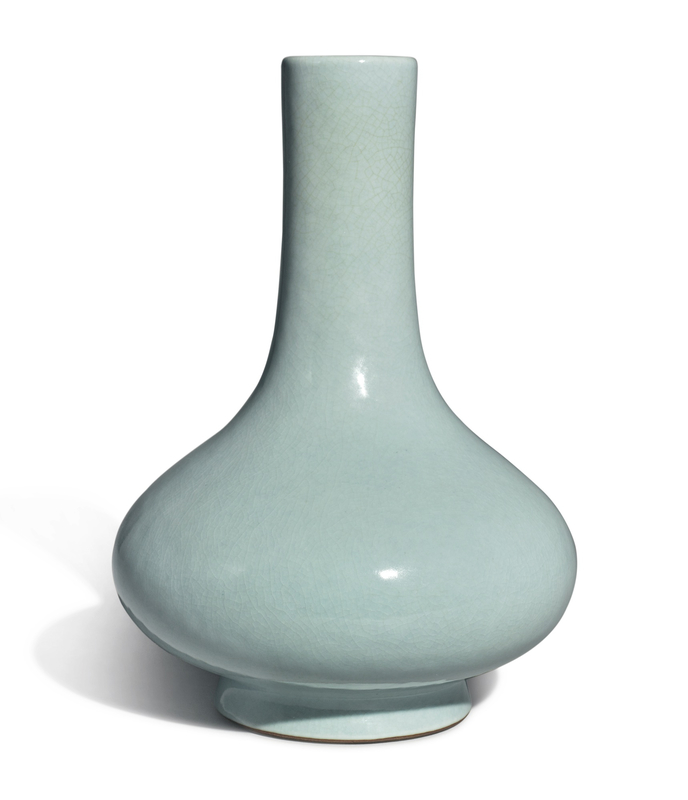A fine and rare Ru-type bottle vase, Qianlong seal mark and period (1736-1795)
Lot 627. A fine and rare Ru-type bottle vase, Qianlong seal mark and period (1736-1795). Height 10 1/2 in., 26.6 cm. Estimate 100,000 — 150,000 USD. Lot Sold 312,500 USD. © Sotheby's.
elegantly potted with a compressed globular body sweeping up to a tall cylindrical neck with a straight mouth, all supported on a short splayed foot, covered overall in a thick pale blue-gray glaze suffused throughout with a fine network of craquelure, the foot dressed in a brown wash faithfully imitating Song dynasty Ru ware, the base inscribed in underglaze blue with a six-character seal mark.
Provenance: Christie's New York, 2nd June 1989, lot 188.
For the Song prototype, compare the Southern Song Ru ware vase with slender neck and everted mouthrim from the Sir Percival David Foundation of Chinese Art at the British Museum, illustrated in Regina Krahl and Jessica Harrison-Hall, The British Museum Chinese Ceramics: Highlights of the Sir Percival David Collection, Beijing, 2013, pl. 5.
While a profusion of new shapes for porcelain vases was already developed in the Yongzheng period, in the Qianlong reign the number of variations multiplied. Geng Baochang, Ming Qing ciqi jianding [Appraisal of Ming and Qing porcelain], Hong Kong, 1993, pp. 259 and 263 publishes over twenty related forms of bottle vases with pear-shaped or globular body and tall slender neck, which often vary only minimally in profile.
Aside from the present example, two other pear-shaped vases of Qianlong mark and period with Ru or guan-type glazes are in the Zande Lou Collection, both included in the Shanghai Museum exhibition, Qing Imperial Monochromes: The Zande Lou Collection, Hong Kong, 2005, cat. no. 28, with the neck more waisted, and cat. no. 33, with a more cylindrical neck. The present shape, with a more depressed body, is otherwise very rare. Compare a closely related vase sold at Christie's Hong Kong, 25th October 1993, lot 804. Another vase of this type with a waisted neck from the collection of the British Rail Pension Fund was sold in our London rooms, 16th May 1989, lot 48; and also a smaller vase from the J. M. Hu Collection was sold in our Hong Kong rooms, 9th October 2012, lot 111.
Sotheby's. Important Chinese Art, New York, 10 september 2019

/https%3A%2F%2Fprofilepics.canalblog.com%2Fprofilepics%2F1%2F0%2F100183.jpg)
/https%3A%2F%2Fstorage.canalblog.com%2F03%2F02%2F119589%2F96711876_o.jpg)
/https%3A%2F%2Fstorage.canalblog.com%2F11%2F31%2F119589%2F94773502_o.jpg)
/https%3A%2F%2Fstorage.canalblog.com%2F20%2F83%2F119589%2F94772815_o.jpg)
/https%3A%2F%2Fstorage.canalblog.com%2F26%2F72%2F119589%2F75604929_o.jpg)
/https%3A%2F%2Fstorage.canalblog.com%2F59%2F60%2F119589%2F26458628_o.jpg)




/image%2F1371349%2F20240331%2Fob_a6f470_2024-nyr-22642-0857-000-a-large-black.jpg)
/image%2F1371349%2F20240329%2Fob_2f6b6c_854-1.jpg)
/image%2F1371349%2F20240329%2Fob_54ca74_114-1.jpg)
/http%3A%2F%2Fstorage.canalblog.com%2F77%2F04%2F119589%2F129856496_o.jpg)